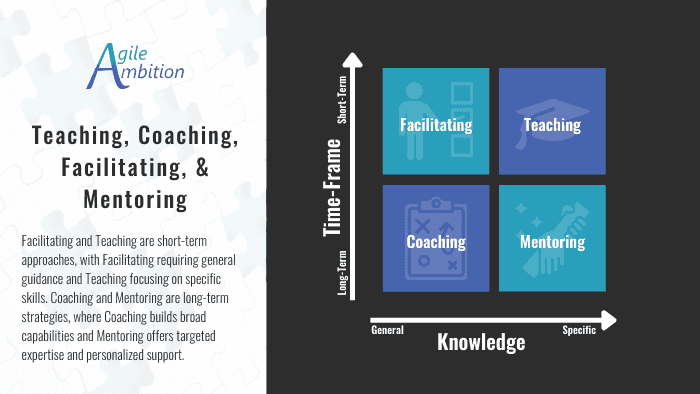Which Accountability Ensures Scrum Is Understood and Enacted

The Scrum framework is like a musical score; the Scrum Master is the conductor. Anyone can read the notes, but the synchronization, interpretation, and adaptation transform noise into melody.
Which Role Is Responsible for Ensuring Scrum Is Understood and Enacted?
The Scrum Master is responsible for ensuring Scrum is understood and enacted. While many think of them as Scrum police, Scrum Masters rely on influence, not authority, to foster a proper understanding of Scrum.
When a conductor steps onto the podium, they’re not exactly wielding power over the musicians. If the horns miss their mark or the oboist botches a note, the conductor can’t just halt the performance and boot them out. It’s not that kind of control—more like guiding everyone to hit that perfect harmony.
The Scrum Master’s in a bit of a tightrope act—no direct authority, yet guiding the team. They don’t get compliance through titles or hierarchy. The team chooses to follow because the Scrum Masters earned their trust, showing over and over that their asks aren’t just noise—they bring value and boost the team’s effectiveness.

In my experience, building influence is one of the trickiest parts of being a Scrum Master. What resonates with one team might not work for another. What motivates one person won’t always inspire the rest. Even the same person might need different approaches in different situations. Guiding someone to their own “aha” moment is a crucial skill for a Scrum Master.
People love to slap the “facilitator” label on the Scrum Master, as if running a few meetings sums up the whole job. Spoiler alert: it doesn’t. I’ve talked before about how this role’s real weight goes unnoticed. If you think all they do is enforce Scrum, think again. That’s barely the start of what they’re there for.
But like everything else a Scrum Master has to wrangle, getting the team to stick to Scrum is hardly ever straightforward.
How Does the Scrum Master Help the Scrum Team Adhere to the Scrum Framework?
The Scrum Master ensures adherence to the Scrum framework by helping the team see the purpose and value of each element. Lacking this, teams follow it as a checklist, leading to zombie Scrum and reduced effectiveness.
There are two main strategies to convince people to experiment with a process. You can show them what happens if they don’t do the thing—spell out the consequences—or demonstrate the value they’ll get when they do it. The first one is the stick; the second is the carrot. Either way, it’s not about forcing anyone’s hand—it’s about getting them to choose it willingly.
In a symphony, the embarrassment of ignoring the composer and wrecking the melody is enough to keep everyone in line with the conductor. Or maybe the applause, the thrill of creating something beautiful as a team, drives them to stick to the score until the very last note.

While the Scrum Master plays a vital role in guiding the team to follow the framework, their efforts are much more effective when the Product Owner is on board.
How Can the Product Owner Support the Scrum Master in Ensuring Scrum Is Followed?
The best way a Product Owner can support the Scrum Master in ensuring Scrum is followed is by modeling adherence themselves. Product Owners should educate stakeholders on how the team’s process delivers value. Often, stakeholders resist Scrum processes—Product Owners help bridge that gap.
From what I’ve seen, a Product Owner can undercut a Scrum implementation in four main ways. Knowing these common pitfalls can help you avoid them and keep the Scrum Master from having to play clean-up. Because let’s face it: a Product Owner who doesn’t get it can throw the whole framework out of whack before you even know what hit you.
- Not Evangelizing the Product Goal: If the Product Owner can’t rally the team around the Product Goal, it’s like sending a group on a road trip without telling them the destination. There is no map, no point of reference, just aimless wandering.
- Being Unavailable to Negotiate Scope: When a developer hits a wall that threatens the Sprint Backlog, they’ll need to renegotiate scope with the Product Owner. Yes, we know you want it all, but we’re telling you upfront—it’s not all going to happen. We need you to step in and prioritize what’s most important, especially if the Sprint Goal doesn’t make it obvious.
- Expediting Unnecessarily: Rushing things through is a fast track to disaster. The whole framework is based on steady, incremental progress. Start slapping on “urgent” labels where they don’t belong, and you’re inviting a meltdown.
- Failing to Educate Stakeholders: If stakeholders think Scrum’s just red tape, they’ll cut right through it, pushing the team back to square one.
Avoiding these common Product Owner missteps is crucial, but ensuring Scrum is well understood involves more strategies than just sidestepping pitfalls.
What Strategies Can Help Ensure Scrum Is Understood and Enacted?
Scrum Masters use four key strategies to ensure Scrum is understood and enacted: teaching, facilitating, coaching, and mentoring. Each of these strategies addresses unique aspects of team understanding, making them vital for successful Scrum adoption.
Teaching, mentoring, facilitating, and coaching are just four ways to slice a 2x2 quadrant, covering broad or narrow topics and working within short or long time frames. It’s all about finding the right fit for the situation.
All four strategies are ways to impart knowledge and techniques that help the team see the value in specific Scrum elements. It’s about showing—not telling—why each piece matters.
It’s better to let the team wade into Scrum, not drown in it. Start with the basics—a goal to aim for and a retrospective to reflect on. Let them live it and learn it, piece by piece, rather than dumping the whole process on them in one go. That way, they’re not just going through the motions. They’re getting what Scrum’s all about.

While teaching, mentoring, facilitating, and coaching can guide a team through Scrum, having practical tools can reinforce these strategies.
What Tools Can Help Ensure Scrum Is Understood and Enacted?
The Scrum Guide is the key tool to help ensure Scrum is understood and enacted, as it defines all core elements. Problem-solving frameworks, however, help solve the gaps. The Scrum Guide sets expectations, but frameworks turn theory into practical solutions.
A tool I’d highly recommend for working through a gap analysis and tackling team dysfunctions is Dysfunction Mapping. Michael Lloyd created a practical framework that helps you pinpoint root issues, connect the dots, and develop targeted experiments to drive meaningful change.
Another excellent tool—though not specific to Scrum—is Mountain Goat Software’s Elements of Agile℠ Assessment. If you’re into that, you might also want to explore maturity models and assessments. Just know they’re not everyone’s cup of tea and can be controversial.
The last tool I recommend is the Process Related Issue Resolution Model.

Yes, I know, the name’s a total mouthful. It sounds like something cooked up in a corporate lab. But don’t let the dry label fool you; this one’s worth your time.
Having the right tools helps keep Scrum in check, sure. But what if the Scrum Master doesn’t enforce the framework effectively?
What Happens If the Scrum Master Fails to Enforce Scrum?
If the Scrum Master doesn’t enforce Scrum, teams can abandon essential practices, causing unclear roles, responsibilities, and process breakdowns. Without enforcement, they tend to revert to old habits, making Scrum ineffective—but the consequences can go much deeper.
I’m not a full-blown Scrum zealot, but I’m closer to that end of the spectrum than the folks who think it’s pure trash and that its spread will signal the collapse of corporate competence as we know it.

Imagine the cacophony if only some musicians chose to follow the score—skipping the challenging parts or cutting what they didn’t like. What’s left would be an ear-splitting mess, and you’d probably blame the composer for the disaster, even though the song they’re butchering barely resembles the original masterpiece.
In my experience, it’s the same with Scrum. If you’re going to do Scrum, do Scrum. If you want to do something else, that’s fine, but don’t call it Scrum. Either way, you should always be experimenting to find what works best for your team and context. There’s no one-size-fits-all approach —that’s why Scrum is a framework, not a method.
So, if enforcing Scrum is crucial for maintaining alignment and avoiding chaos, what steps can a Scrum team take to improve its adherence to the framework?
How Can a Scrum Team Improve Its Adherence to Scrum?
Teams can improve their adherence to Scrum by regularly reviewing the Scrum Guide to reinforce understanding. Many teams assume they know Scrum but miss out on crucial nuances by not revisiting the guide, which can lead to gradual deviations from core principles over time.
I can’t stress this enough: read and re-read the Scrum Guide. It never ceases to amaze me how many people gripe about aspects of Scrum that aren’t even part of Scrum—or worse, ditch key elements that they deem “unnecessary.” The craziest part? There’s an entire population out there that somehow learned about Scrum without ever hearing of the Scrum Guide’s existence. I have no clue how that happened, but if you’re one of those people, just read the damn Scrum Guide. It’s not rocket science.

You can do a gap analysis once you’ve read the Scrum Guide. What are you doing that’s not in the guide? Why are you doing it? Does it bring value? Keep it. If not, drop it. Now, what’s in the guide that you’re not doing? Why’s it there in the first place? Are you struggling with something this element could solve? Or does it seem like it’d make things smoother? Then, it’s time to start doing it. It’s as simple as that.
TLDR
Like a symphony, when every Scrum accountability plays in harmony, the result is greater than the sum of its parts. So, if you want your team to deliver value rather than just noise, let the Scrum Master guide the rhythm, and trust the score.
Works Consulted
- Scrum Guide
- Agile Manifesto
- What Is One Accountability of a Scrum Master
- Process Related Issue Resolution Model
- Facilitating, Teaching, Mentoring, and Coaching
- Why should scrum masters consider a gradual introduction to scrum?
- Dysfunction Mapping; A tool for effective Agile Coaching
- Elements of Agile℠ Assessment
- Here’s What’s Wrong with Maturity Models
Share
Table Of Contents
Fuel an Idea
Every week, I break down complex ideas, strip away the fluff, and give you experiments to turn knowledge into skills.
If that’s worth a coffee, consider fueling the next big insight.
No pressure. No guilt trips. Just impact.
Buy Me a CoffeeRelated Posts
Quick Links
Legal Stuff

